|
|
 Young Tong Hall, Green Roof Temple and Monk
Fruit Young Tong Hall, Green Roof Temple and Monk
Fruit
|
|
The first stop of
Dakeng's ecotourism tour was to visit "Jheng
Jyue Buddhist Temple." It was built in
1926. Originally it was built with grass and
it is a Buddhist place for female believers
exclusively. While walking toward the gate,
you may find that the well trimmed grass
with green and exuberant is exactly matched
with the the black green eaves of the
temple. Jheng Jyue Buddhist Temple has
been ascribed to Guanyin Gate, so Da SyongTemple is also named Yuan Tong Temple, which
enshrines Guanshiyinpusa in Chinese or
Aualokitesvara Bodhisattva in English.
When you arrive
at the gate, you can see a Guanyin-Buddha
and several clay-Buddhas around the god, all
of which are sitting. Therefore, some people
call this temple as "Zuoshan Temple" or
"Sitting Mountain Temple" translated
literally.
Guangqin old monk
took up residence in Jheng Jyue Temple
before. He visited here and meditated
without eating and resting at that time. It
is said that a group of animals gave him
fruit for eating while he was meditating, so
people also call Guangqin monk as "Monk
Fruit" in an informal way.
|
|
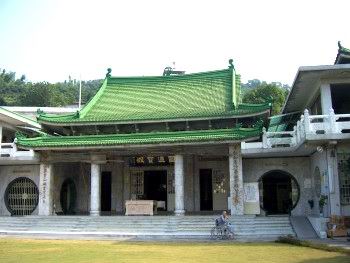
The particular
green roofs in Jheng Jyue Temple
|
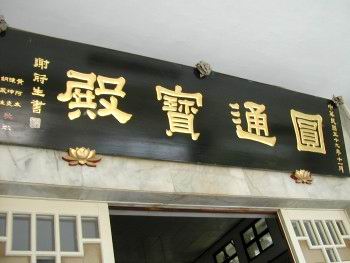
Jheng Jyue
Buddhist Temple belongs to
Young Tong Hall
|
|
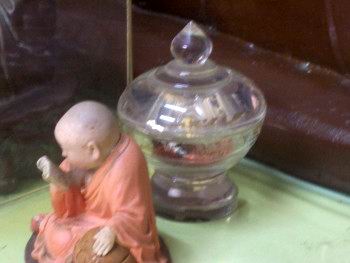
Guangqin monk's
Shariputra
|
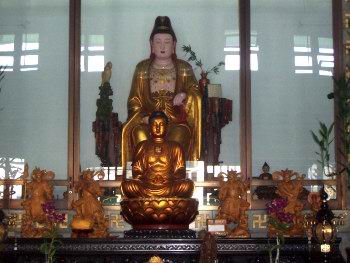
This is
Aualokitesvara Bodhisattva
|
|
 Eight Trigrams Furnaces and kitchen closet Eight Trigrams Furnaces and kitchen closet
|
|
Walking to the
kitchen, you will see a big furnace. We were
all curious how it was made. Took a careful
look. We found there was not only a furnace,
but eight furnaces. After the presenter's
explanation, it was Eight Trigrams Furnaces,
a treasure in Jheng Jyue Buddhist Temple.
It is an ancestral monk's intelligence and
is still used to cook vegetarian food in the
kitchen. One meal that cooked with Eight
Trigrams Furnaces can serve for a thousand
people's banquets. One kitchen accommodates
about 10 people. The cooks can talk while
they are cooking, so the meal is full of
human sentiment.
As implied by the
name, the "Eight Trigrams Furnaces" means
eight furnaces forming the shape of eight
trigrams. The Eight Trigrams Furnaces show
eight angles and have four big furnaces and
four small furnaces. There is a faucet on
each furnace. The fire of each furnace is
independent but the cooks can share with the
sauce. The Eight Trigrams Furnaces are
convenient, organized, unique and practical
without occupying the other space. Every
second one has a concave hole for the cook
to stand on. If there are not enough cooks,
one cook will be responsible for two
furnaces. After Master Shanzheng served as a
host three decades ago, the temple's incense
got more flourishing. The temple was
reconstructed. Believers from everywhere
came to pray the well-known and prominent
the Aualokitesvara Bodhisattva
at temple fair three times a year. Many of
them decided to eat vegetarian food in the
temple. To solve the meal problem,
Master Shanzheng created today's
"Eight Trigrams Furnaces."
Offsprings
benefit from the ancestor's intelligence.
Even though a thousand people have the meal,
there will have no difficulty in serving the
food on time. After the 921 earthquake, many
Dakeng's areas lacked water and electricity,
even the gas. When Ci Ji Foundation came to
the disaster areas, they also used the
convenience of Eight Trigrams Furnaces to
solve the victims' living problems. However,
a fly in the ointment is the dining room was
too small. Luckily, the intelligent old monk
discovered a special kitchen closet. It is
not normal! It is a two sided kitchen
closet. The most special function is when
the food is ready, place it in this closet
and the people in the dining room can
readily take food out from here. It is so
convenient!
Although the
residents lack resources, the gas or natural
gas has become a necessary appliance in a
general family. Eight Trigrams
Furnaces still take useless wood as the
fuel, which become the predecessor for
recycling. The idea of Eight Trigrams
Furnaces is rarely seen in Taiwan. The
Eight Trigrams Furnaces, Dakeng's
historical relic, are still used for cooking
by lighting woods every day. It is Dakeng's
vivid honey.
|
|
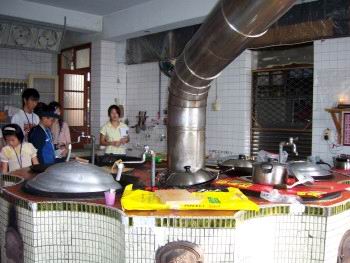
Eight Trigrams
Furnaces has fume extractor
|
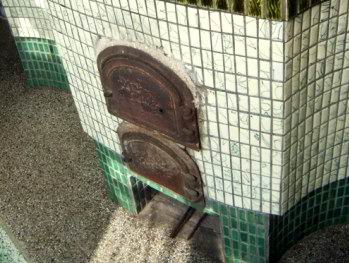
The lighted wood
in the Eight Trigrams Furnaces
|
|
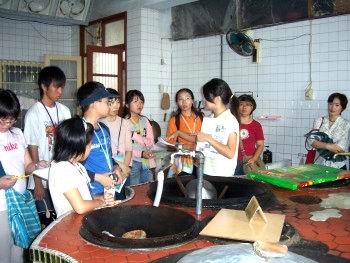
The presenter
told us the story of Eight Trigrams Furnaces
|
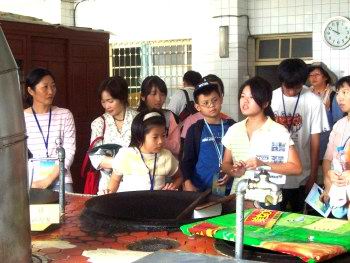
Everyone was
curious about Eight Trigrams Furnaces
|
|
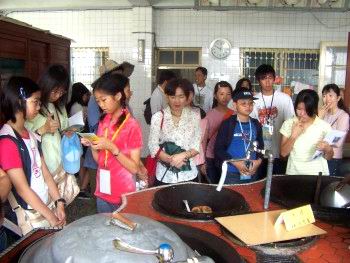
Is there any
special function on Eight Trigrams Furnaces
|
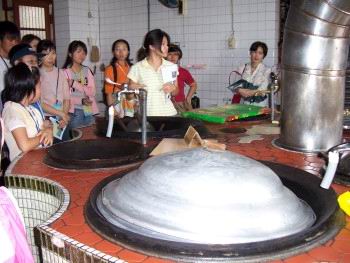
Each furnace has
a faucet
|
|
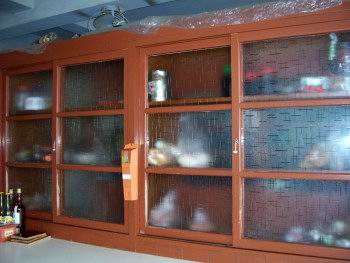
This is two-sided
kitchen closet
|
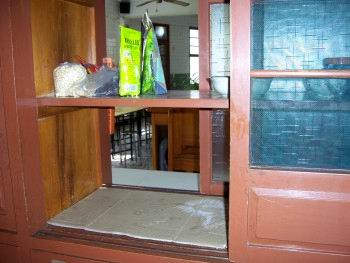
The kitchen and
the dining room are communicable
|
|
 Gujing
"a well with the drum's shape " and Yuban "
the percussion instrument"
Gujing
"a well with the drum's shape " and Yuban "
the percussion instrument"
|
|
After listening
the introduction of Eight Trigrams Furnaces,
we reached to their former place to drink
water. Looked down at the ground, there was
a hole with the drum's shape. Originally it
was a well, called " Gujing." Don't look
down at it. It was a clean and clear well
for people to drink. Some people came here
on purpose to take water! It is a pity that
nobody uses this well today because the
water in the well is too low, people are
afraid of falling down. The other reason is
that the quality of water in the well is not
as good as before and it is replaced by the
tap-water so that people don't take water
hard as before.
On the well's
back wall is a special coin with the
cloud's shape. There is a protruding circle
in the middle where there is a little
hammer. This is Yuban "the percussion
instrument." Originally it is a clock that
is used to assemble everyone for eating. At
the moment it is not the right time to have
the meal, so everyone needs to control
oneself to knock the clock. It is always
silent in the temple, so a person would play
the Yuban to call everyone for eating.
|
|
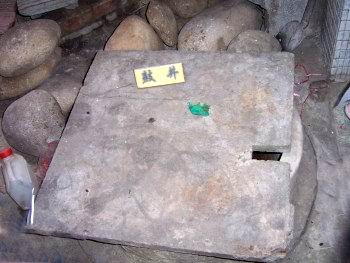
Gujing is a place
for ancient people to drink
|
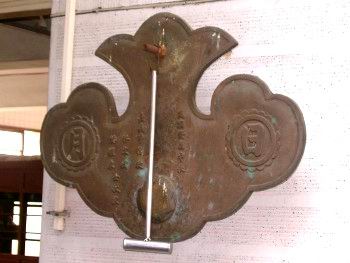
Yuban is a clock
to call people for having the meal
|
|
 Jiu Bu
Siang or "Nine unlikenesses" translated
literally
Jiu Bu
Siang or "Nine unlikenesses" translated
literally
|
|
Later we came to
the other side of the temple. Here is
Kshitigarbha Bodhisattva for people's
praying. The presenter asked us," Do you see
any special thing?" Teacher Jheng said, "
Isn't there a rectangular box with many
buttons?" It looks very old. What is it
for?" Teacher Li said, " It was a radio
during 1960-70, I saw it when I was a
child." But the presenter wanted us to see
the Kshitigarbha Bodhisattva's guard. She
asked us, "What is it like?" Then all of us
started to discuss it. Yijie said it was
like a lion. Yawen said it was like a dog.
Zihsing said it was like a Chinese unicorn.
Yinsyuan said what the above said were not
all correct, The answer for Kshitigarbha
Bodhisattva's guard is "Di Ting," the
guard's name. Some people call it "nine
unlikenesses." Yijie had lots of interest
and said, " I must check it carefully at
home."
After Yijie and
Weiling looked up the information about Jiu
Bu Siang, they found the
result--Kshitigarbha Bodhisattva's guard is
a monster like a lion but it doesn't exist
on earth. Its name is Di Ting, also called "
Shan Ting." People said that Di Ting had the
god's power of hearing people's prayers on
earth and listen to Shihfang-Buddha's
words. It is a pioneer. Originally it was a
white dog to accompany Jin Ciao Jyue Si for
studying the god's power. Later it became
the god's guard. The better ear is straight
up to listen to Shihfang-Buddha's
words and the other ear is toward down to
hear the prayers from good and evil people.
The legend said that it can use its ear to
tell a person good or bad. It is really
interesting! But its appearance is so odd.
It has deer horns, camel's head, crab's
eyes, horse's mouth, cow's ears, sheep's
moustache, lion's hair, carp's scales,
snake's body, eagle's claw and tiger's palm.
It looks like a dragon in one of the legends
imagined by our ancestors but
there was no final conclusion for its shape.
Therefore, there is a
saying, “ Nine likenesses, nine
unlikenesses.” This is the origin of
Jiu Bu Siang “nine
unlikenesses.” After looking up the
information, I finally understood the “life
experiences” of Jiu Bu Siang
.
|
|
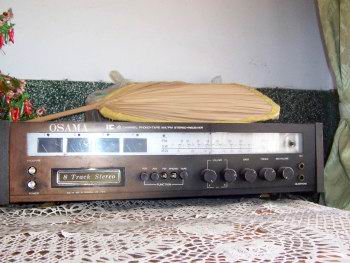
A radio during
1960-70
|
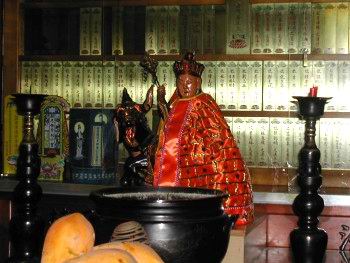
Kshitigarbha
Bodhisattva's guard, Jiu Bu Siang
|
Written by Tzu-Hsing, Huang and Tiffany Liao
|
